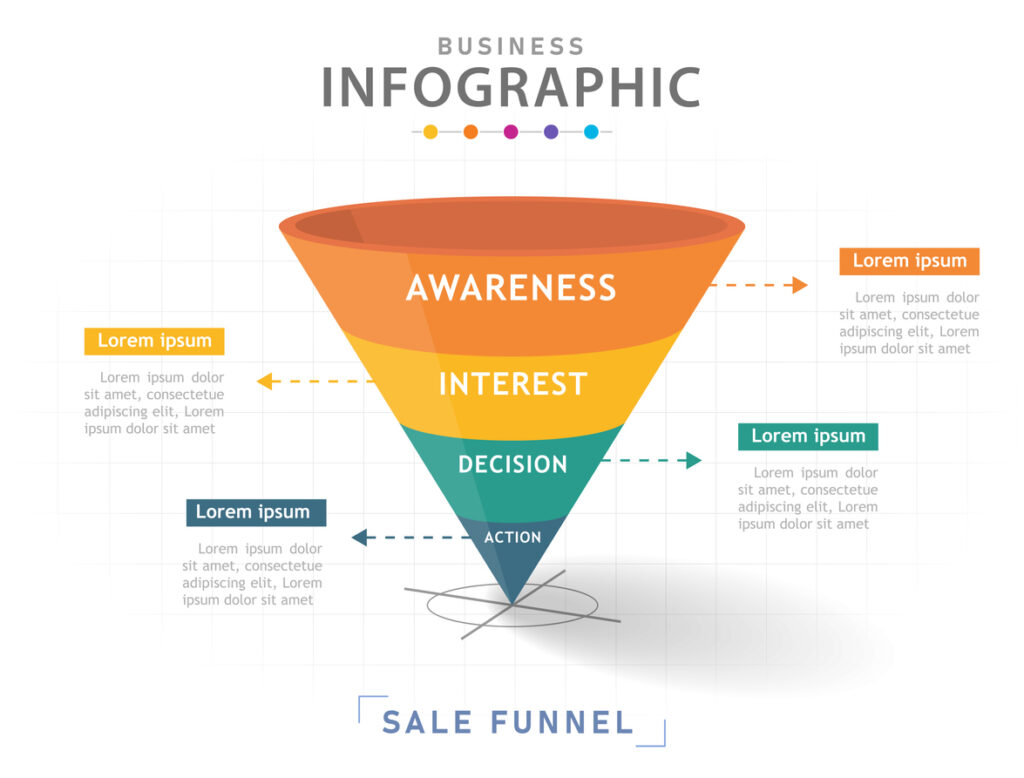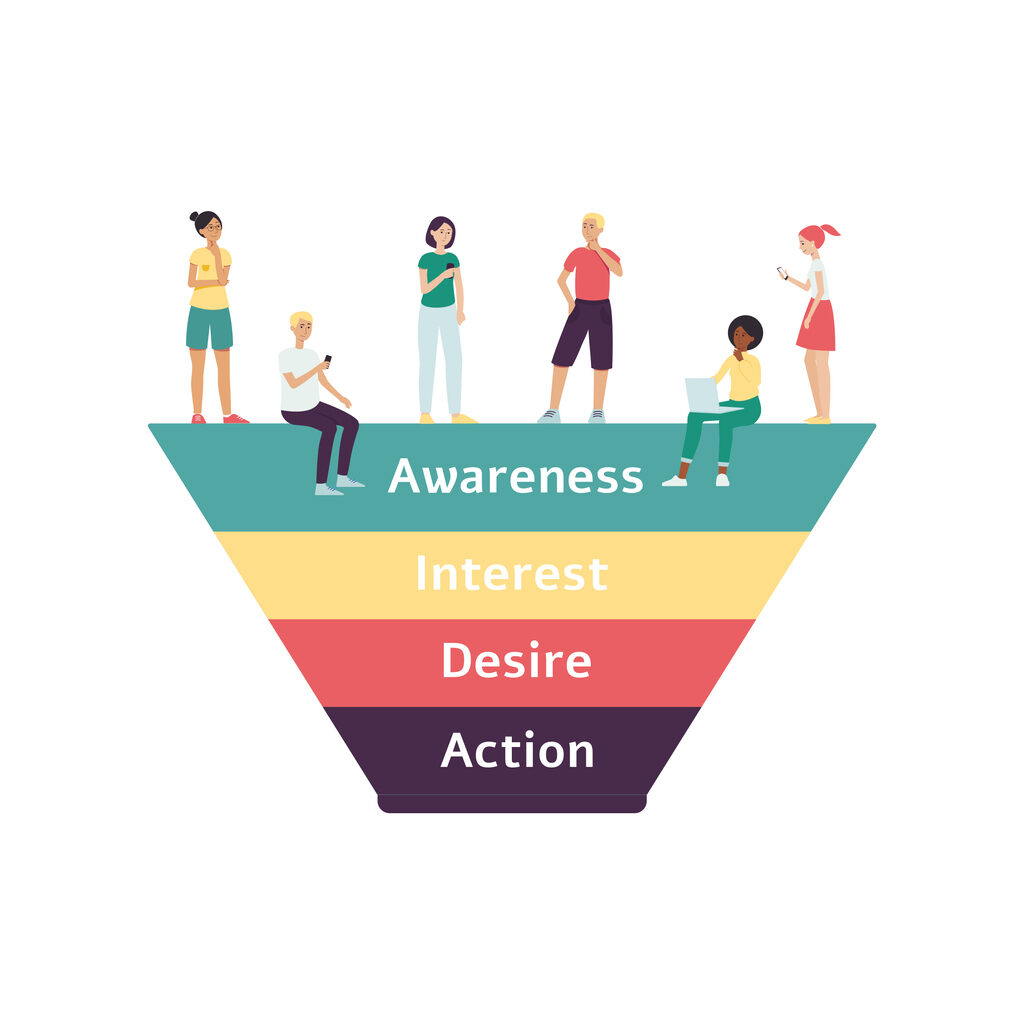
What Is A Marketing Funnel?
A marketing funnel visual represents your customer’s journey with you. From the moment someone discovers your brand to the point of purchase, marketing funnels chart the path to conversion and beyond.
A marketing funnel, when properly analyzed, reveals what your organization needs to do to influence consumers at various phases. Examining your sales funnels can significantly increase sales, loyalty, and brand awareness.
Main Stages Of The Marketing Funnel?
Prospects walk through several stages of your sales funnel, from the minute they learn about your product or service to the moment they make a purchase (or do not make one). While the path through your funnel may vary depending on the prospect, they will ultimately evaluate it based on their level of interest. They’ll consider the issue at hand and perform competitive research to ensure your service is the best fit.

What Are the Stages of the Marketing Funnel
1. Awareness
The first stage of the sales funnel is referred to as the “awareness” stage, as it is during this stage that individuals first become aware of your product or service. They may become aware of you due to your advertising, Google search, social media presence, or simply word of mouth.
Of course, how and why those prospects go down the sales funnel is entirely dependent on your sales and marketing abilities.
2. Interest
After learning about your brand, prospects will evaluate it depending on their level of interest. They’ll consider the issue at hand and perform competitive research to ensure your service is the best fit. Effective marketing will produce more developed and complete content covering ways and strategies to resolve the identified problem or opportunity. The leads in the middle and lower stages of the sales funnel are the ones you want to focus on the most since they have progressed from awareness to interest.
Again, consider whether your material is serving its intended purpose:
- Are individuals converting as a result of this content?
- Is this content producing new sales or leads?
- Is this content beneficial or detrimental to my end goal?
Consider the following content forms during this stage:
- Case studies, customer testimonials, white papers
- Webinars
- Sales calls
- Podcasts/Videos

3. Determination
This step is where you separate the wheat from the chaff. A typical funnel begins at the top and gradually becomes smaller as it descends. The decision step of the marketing funnel is the smallest. Once you have brought a possible lead to consciousness and evaluated it, it is ready to be marketed.
It is your opportunity to make your sales pitch. However, it would help if you did it with tact. The best practices for the decision stage are to put forth your business’s primary differentiating qualities and essential benefits.
4. Taking Action
All of your efforts culminate at this point: whether the prospect purchases or not. If they did not, the deal is not irreversibly lost. You can design nurturing campaigns to ensure that your brand remains top-of-mind. Everyone desires to feel secure when making a purchase. Provide compelling reasons for potential customers to purchase your goods or invest in your service.
The purpose of the content funnel thus far has been to generate interest in your product. Give consumers a cause to buy at the bottom of the content marketing funnel. By comparing identical products side by side and emphasizing how your product or service is superior, you can easily influence a purchase.
Again, bear the following in mind:
- Is there a clear call to action in my content?
- Am I simplifying the purchasing process?
Offering a free trial of your services can potentially result in a purchase, as long as you are not distributing the entire product for free. An initial test provides a taste of what you do but should leave potential customers wanting more, as your goal is to convert them into a sale.
Content to include in the buyer’s journey is much more valuable and exclusive. These include:
- Vendor comparisons
- Product comparisons
- Case studies
- Trial downloads
- Product literature
- Live demos
- Personal consultations
Tips On Implementing A Successful Marketing Funnel
They include:
- Focus on your clients, and don’t forget that clients are different. Think of your different audience personas and work on each.
- Listen to your clients carefully and work on their needs.
- Your business must improve customer service. Customers can reach you in a variety of ways. We advise the presence on numerous channels because each has a distinct audience.
- Consider the customer’s journey.
- Use SEO to direct potential buyers. Be sure to understand their needs.
Your carefully created material will be wasted if your clients cannot find it online. You must guide prospects through the web search process. Utilize a search engine optimization technique to direct a buyer to a particular web page. The following is a five-step plan:
- Define your audience and their requirements
- Sort keyword research into categories
- Identify potential gaps and opportunities
- Define your adversaries
- What are your rivals up to?
Now, modify your SEO approach to integrate the information shown above.
6. Give fantastic experiences at every touchpoint.
These touchpoints allow your organization to better connect with clients.
Bottom Line
It is self-evident that the purchasing process does not follow a linear path. Individuals come and go. Each customer is unique, and deciphering their intent is not a simple matter of facts. The customer’s perspective is more critical than ever. You must ascertain what motivates your customers. By carefully defining and developing relevant content for each stage of the buyer’s journey, you can effortlessly move your prospect through the marketing funnel – and ultimately convert them into a devoted customer! At Skill Surfing, we offer expert-led courses that include live mentoring, enabling you to immediately apply best content practices in your organization.
Marketing funnels are explained in this Skill Surfing program which will guide you to design a marketing funnel that works for you and your business with strategies to turn a stranger into a customer.
For more information, contact us.